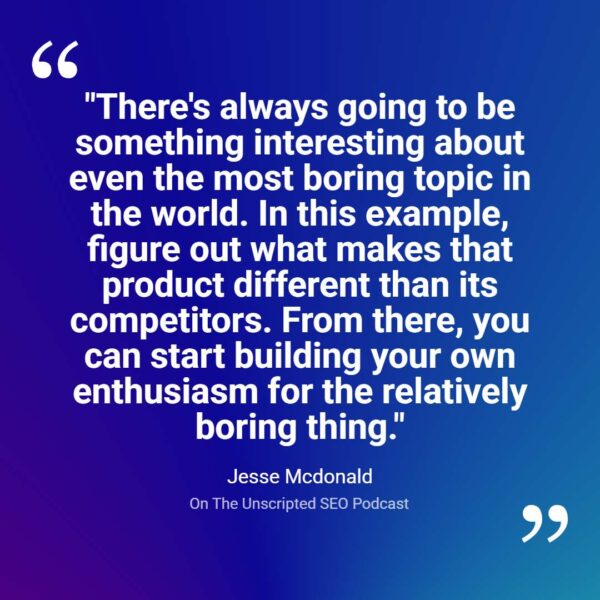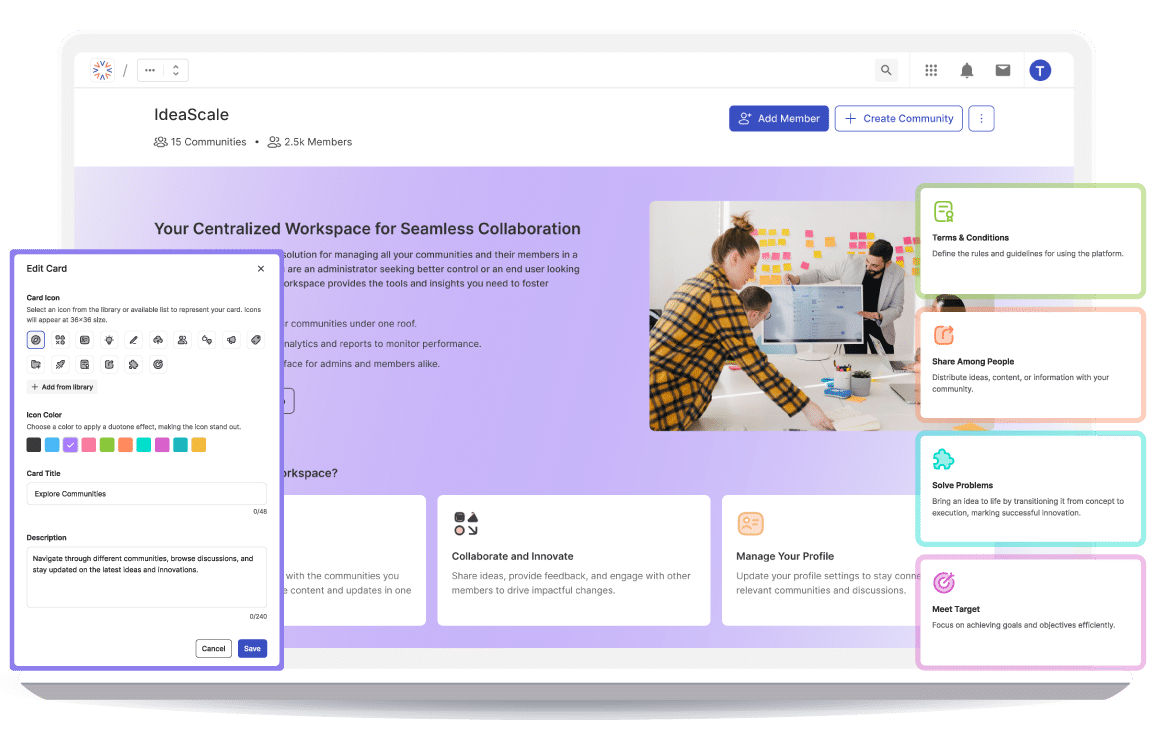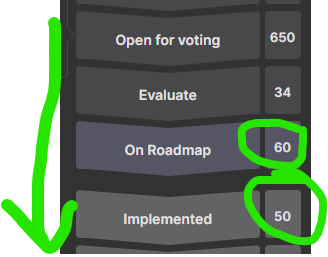For innovation-focused startups, building a compelling digital presence is critical—but what happens when your industry doesn’t naturally generate excitement? How do you create engaging content when your groundbreaking solution operates in what many might perceive as a “boring” sector?
SEO experts Jesse McDonald and Jeremy Rivera recently explored this challenge, offering insights that can help innovators transform seemingly mundane offerings into compelling digital narratives that attract the right audience.
The Innovator’s Content Challenge
Jeremy Rivera: “How do you thrive when you’ve got a client that’s super boring? They do medical affairs insights and you’re not exactly sure what that is. It’s some sort of esoteric B2B play. Or they sell waste oil heater recyclers that motor shops can use to turn used motor oil into heating products for their own shop. When it’s super boring, where do you go?”
This question resonates with many innovators whose solutions address critical industry needs but don’t naturally generate viral content. Consider services like fixing crawl spaces in Tennessee—essential for home ownership but not typically associated with cutting-edge innovation.
Diving Deeper: The Conversation Continues
Jesse McDonald: “I mean, for me, this comes from having a grandfather early on in my life, which he passed when I was young. So I don’t remember much of him, but I do know this. That man would just read the encyclopedia all the time. He just found the world interesting and wanted to know more about it.”
Jeremy Rivera: “Okay.”
Jesse McDonald: “So, and like him and I would hang out on MS DOS when I was like five, four or five and like we would code fire engines together and stuff. But that mentality of just like, just learn, just hop in and learn, dive into the interesting part of it. There’s always going to be something interesting about even the most boring topic in the world.”
Jeremy Rivera: “Tell me how that works? I mean, I have a commercial kitchen cost saving appliance client, so I’d love to hear how to apply that to them.”
Jesse McDonald: “So in this example, figure out what makes that product different than its competitors. And then from there, you can kind of start building your own enthusiasm for the kind of relatively boring thing. Take for example a car dealership they’re a very common business model, but how you approach the market, how you flip expectations or deliver value matters”
This curiosity-driven approach aligns perfectly with the innovation mindset. By exploring your industry’s complexities and challenges more deeply, you not only develop better solutions but also uncover unique content angles that competitors miss.
From Interest to Enthusiasm: Building Momentum
Jesse McDonald: “And then that’ll give you kind of that pep in your step to move forward with it and find, you know, a unique way to position it and market it through your, your efforts and initiatives. But I mean, you it can be super challenging and even on the other side of things, something could be super interesting, but so highly technical that it’s out of your kind of wheelhouse.” It’s like delving deep into diminished value assessment, which sounds like a complicated accounting procedure, but when you put it in terms of value to people who were in car accidents being fairly compensated? It makes more sense.
Jesse McDonald: “You just kind of have to dive into it and go, you know, what does this mean? Let me figure it out. I had to do that a lot at IBM. When I started there, I was the focal from the CHQ SEO team within the cloud business unit for SEO. So basically acted like an internal consultant to that business units team.”
But going into that, I mean, other than cloud is a computer that you access through the internet, that’s all that I really knew about it at a very broad level. So I had to do a lot of like sitting down into our internal trainings and stuff about our cloud system and figure out what does it mean.”
For many innovators, the challenge isn’t just that their industry seems boring—it’s that their breakthrough is highly technical and difficult to communicate. McDonald’s IBM experience demonstrates how investing time to truly understand complexity pays dividends.
The Challenge of Technical Complexity
Jesse McDonald: “What do all of these other things mean that are connected within it? Then what does that actually mean outside of the marketing jargon? Let me set up some time with the sales team to just go, what in the hell is this talking about?”
Jeremy Rivera: “Yeah.”
Jesse McDonald: “And then from there, I’ve built a knowledge of it to where, you know, I couldn’t go in and like program anything with a cloud or anything like that. Cause that’s just not my skillset. It could be if I really wanted it to be, but that’s not where I’m trying to go. But I know enough now to where it’s, it’s helped me moving forward.”
This investment in translating technical complexity into clear communication creates lasting advantages in both marketing and product development.
Finding Innovation Stories in Every Industry
Even the most technical or specialized innovations have fascinating aspects waiting to be highlighted. For startups, this means:
- Highlighting the specific problem that sparked your innovation journey
- Documenting the iterations and failures that led to your breakthrough
- Showcasing the impact metrics that demonstrate your solution’s value
- Explaining how your approach differs from conventional wisdom
There’s actually a really solid case for holding a small industry specific networking event, maybe even spring for renting a photobooth to make it fun. This is a great opportunity to understand the challenges in your specific niche or vertical. Even better if you do one-on-one question sessions with guests. You can take those transcripts and find some marketing gold. But also don’t forget to use the event marketing opportunity to build links through event aggregators too!
The Compounding Value of Industry Knowledge
Jesse McDonald: “Cause we work with a lot of SaaS companies at Siege. So I can say, Hey, I at least have some level of experience in this. When you talk about containerization, I know what you mean, at least at the most broad perspective. So I can help provide that information.”
Jeremy Rivera: “Mm-hmm.”
Jesse McDonald: “So realistically at the end of the day, a thirst for knowledge will help you regardless in your current situation and in the long term.”
For innovators, the time invested in understanding your industry’s complexities creates lasting advantages that extend far beyond marketing to enhance product development, investor pitches, and future opportunity identification.
Five Content Strategies for Innovation-Driven Startups
- Document your discovery process – The journey to your innovation often contains more engaging content than the solution itself
- Humanize the problem – Create content that shows the real-world impact of the problem your innovation solves
- Simplify technical concepts – Develop analogies and visualizations that make complex innovations accessible
- Highlight unexpected applications – Show how your solution applies beyond its primary use case
- Connect with industry pain points – Frame your content around the specific challenges that your target audience faces daily
Balancing Technical Depth with Accessibility
Jeremy Rivera: “You mentioned containerization, and that’s something that I’m sure the developers at IBM knew inside and out. But how did you find that balance between getting too technical and keeping it accessible?”
Jesse McDonald: “That’s a great question. I think it comes down to understanding your audience’s needs. The developers want the deep technical details, but the marketing content needed to be accessible to business decision-makers who might not have that technical background.”
Jeremy Rivera: “Right, so it’s about translation.”
Jesse McDonald: “Exactly. I needed to understand enough to know what made our solution special, but then translate that into benefits and outcomes that a CTO or business leader would care about. Instead of explaining all the intricacies of our containerization approach, we’d focus on how it makes deployment faster, more reliable, and more secure—outcomes any business leader can appreciate.”
This approach to technical translation is essential for innovators in complex fields—understanding deeply, but communicating clearly.
Leveraging Enthusiasm as a Competitive Advantage
Once you’ve found your compelling angle, enthusiasm becomes a differentiator, energizing not just your content creation but ultimately engaging your audience and investors.
Jeremy Rivera: “So would you say that this enthusiasm and curiosity are actually competitive advantages in marketing these ‘boring’ products?”
Jesse McDonald: “Without a doubt. When you genuinely understand and care about what makes your product valuable, that authenticity comes through in your content. Even if you’re selling industrial parts or stair hand rails and working in industries where most marketing is dry and technical, having content that’s both accurate and engaging immediately sets you apart.”
Conclusion: Innovation Makes Any Industry Fascinating
When approached through the lens of problem-solving and transformation, there are no truly “boring” industries—only opportunities to connect valuable innovations with the people who need them most.
The most successful digital strategies for technical startups don’t try to artificially inject excitement—they focus on communicating genuine value to decision-makers who understand the real-world problems being solved. By embracing what makes your innovation uniquely valuable, you create content that resonates with your specific audience, even if your industry doesn’t naturally generate broad public interest.
Jeremy Rivera: “Any final thoughts for our innovators working in these supposedly ‘boring’ industries?”
Jesse McDonald: “Remember that you created your solution because you saw a problem worth solving. That original spark—that moment where you recognized a need that others weren’t addressing—contains the seeds of your most compelling content. The technical aspects matter, but the human story of why it matters is what will ultimately connect with your audience.”
In the innovation ecosystem, it’s often the supposedly “boring” niches that offer the greatest opportunities for meaningful impact and sustainable growth.
This article draws from a conversation between SEO experts that offers valuable perspectives for innovators in any industry. Listen to the full episode for more insights. You can also explore a quick overview or an in-depth recap of their discussion.
Most Recent Posts
Explore the latest innovation insights and trends with our recent blog posts.













